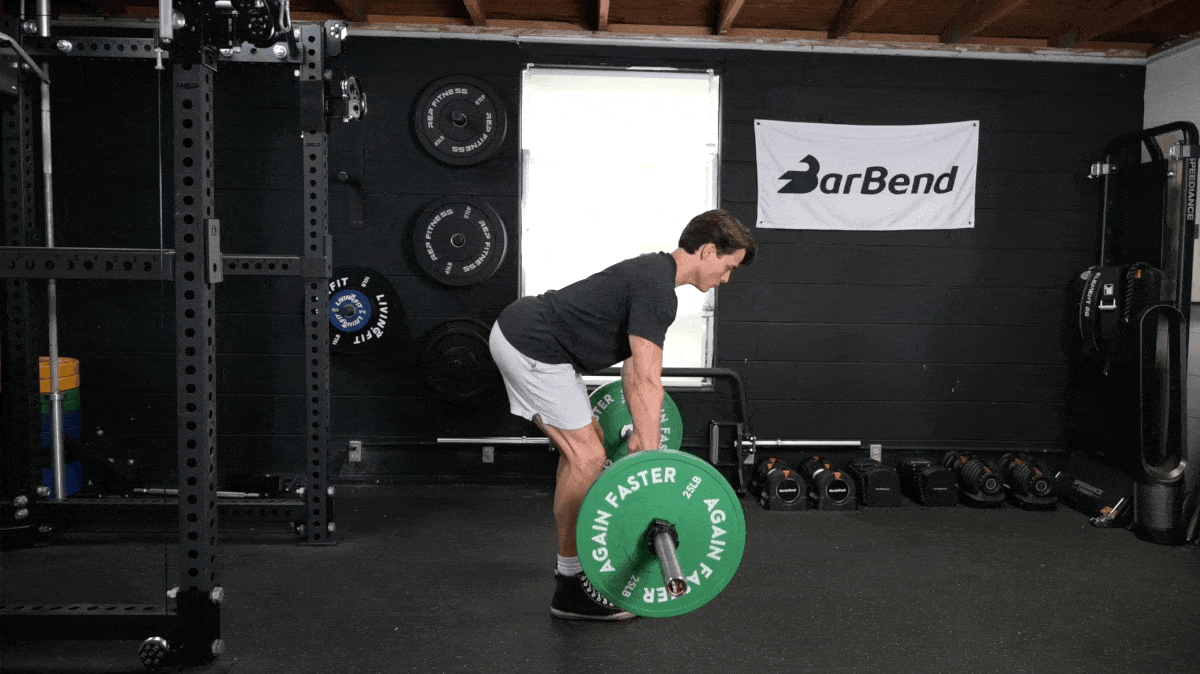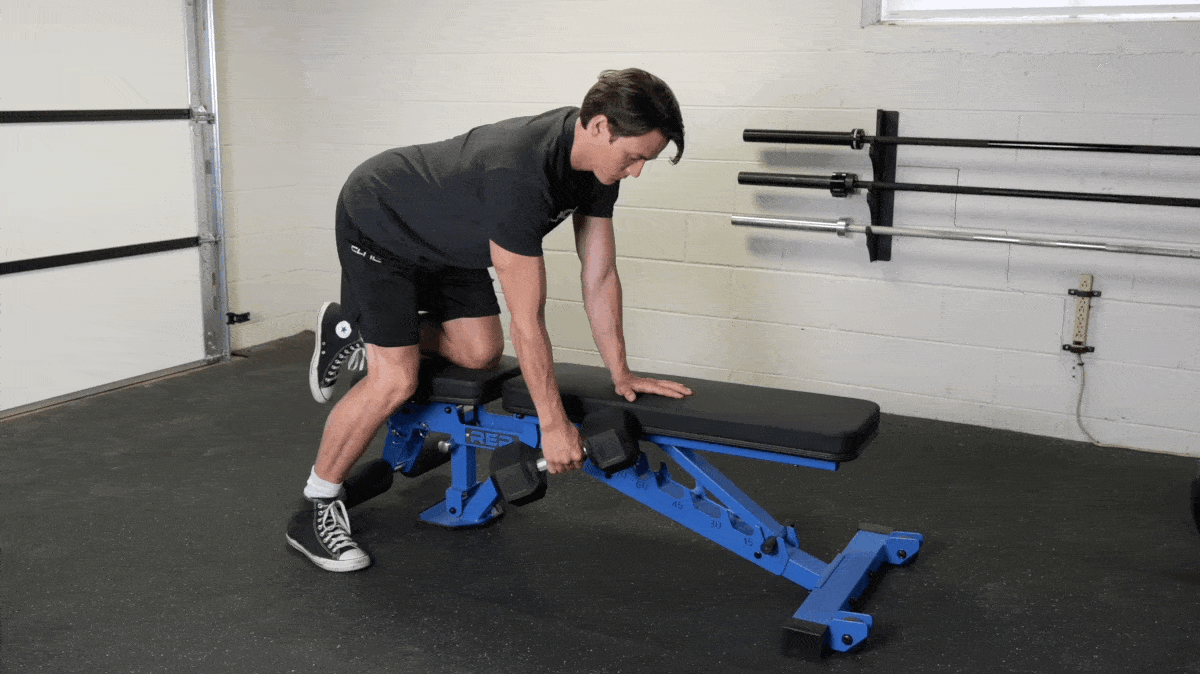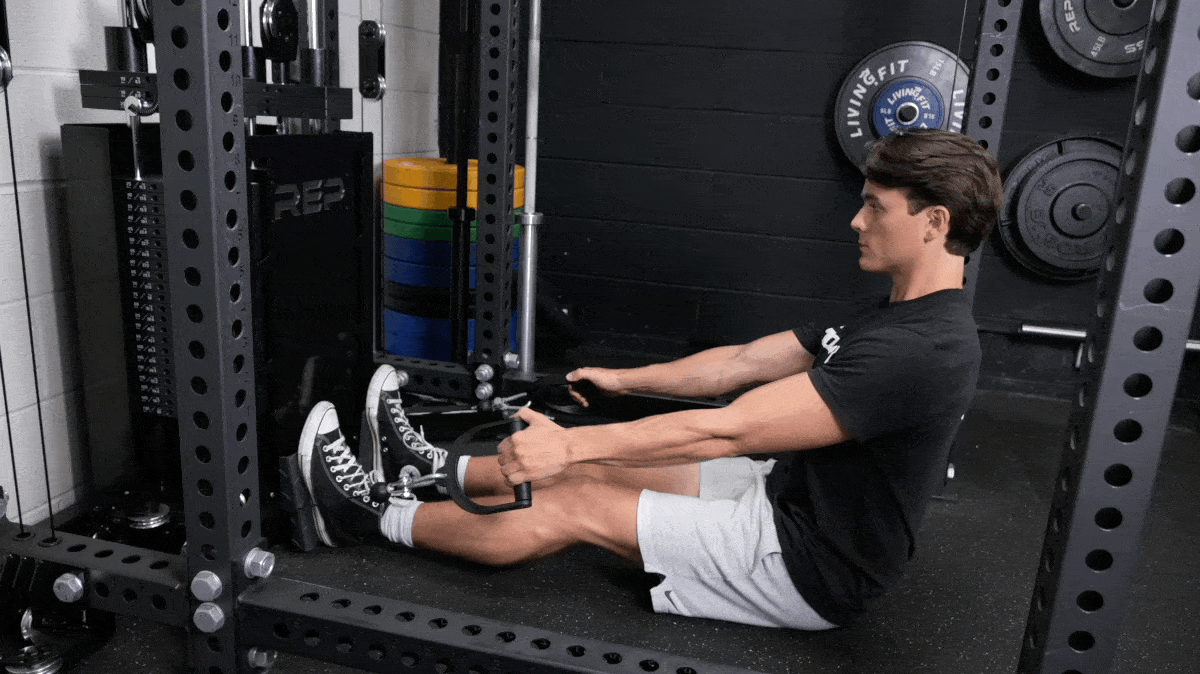You won’t do much better than the barbell row when it comes to gaining back strength and size. Better yet, the strength you gain from rowing a heavy barbell in a hinged position carries over to almost everything else you do both in and out of the gym.
Put simply, we think barbell rows are one of the best back exercises out there. Read up below for a step-by-step instructional on how to do the movement, plus variations, alternatives, and why we think the barbell row belongs in your next back workout.
Recent Updates: On May 15, 2024, BarBend Senior Writer Jake Dickson updated this article to ensure the content aligns with BarBend‘s evolving standards for accessible, holistic strength training prescriptions. You can read up on how we make those decisions here.
How To Do the Barbell Row

[Read More: Do Different Row Grips Matter?]
- Step 1 — Stand upright with your feet under your hips and holding a barbell with a double-overhand grip just outside your thighs.
- Step 2 — Tip over by pushing your butt backward while keeping your knees mostly straight, allowing the bar to slide down until it reaches around your kneecaps.
- Step 3 — Brace your core, keep your back flat, and pull the bar up towards your lower abdomen. Keep your upper arms tucked tightly to your sides.
Coach’s Tip: “You don’t need to pull the bar all the way up to your belly when you row,” says Dickson. “Just try to get your elbows in line with your torso and you’re good to go.”
Sets and Reps
- Build Muscle: 4 x 8
- Gain Strength: 3 x 6
- Improve Endurance: 3 x 15
Modifications
- Make It Easier: An upright barbell row provides more leverage than tipping all the way over. Pitching your torso at a 45-degree angle will also reduce some of the stress the exercise places upon your lower back.
- Make It Harder: Try pausing with the bar up against your stomach on every repetition to emphasize isometric shoulder stability.
Video Guide
You can also check out this video tutorial from Jake Boly, BarBend‘s former training editor, to learn how to do barbell rows:
Barbell Row Variations
“I’m a sucker for row variations during my back workouts, and the barbell row is a go-to,” Dickson says. “However, not everyone enjoys them. Luckily, swapping out the barbell row for a variation can make a big difference without impacting your results.”
- Seal Row: This row variation fully supports your torso, reducing the stress on your spine to almost zero. However, it can be tedious to set up.
- Pendlay Row: Named for renowned Olympic lifting coach Glenn Pendlay as one of his go-to weightlifting accessory exercises, the Pendlay row prioritizes training for power and rapid movement.
[Read More: T-Bar Row vs. Barbell Row — Which Back Builder Is Best for You?]
Barbell Row Alternatives
If you enjoy training your back but don’t want to do barbell rows specifically, don’t fret — there are plenty of barbell row alternatives available if you’d rather do something else while still working toward your goals.
Dumbbell Row

[Read More: Barbell Row Vs. Dumbbell Row — Which Is Best for Strength, Hypertrophy, and Fitness?]
- Set up on a flat weight bench by placing your non-working palm and corresponding knee onto the bench.
- Bend over and reach down to grasp a dumbbell on the floor.
- Brace your core and pick the dumbbell off the ground, letting your arm hang loosely.
- From here, initiate the dumbbell row by pulling your elbow up and back towards your hip crease.
Dumbbell rows are very similar to bent over barbell rows, but allow you to focus on working your back unilaterally, one side at a time. This is a good swap to make if your lower back is fatigued or vulnerable, or if you have a muscular imbalance you want to address.
Seated Cable Row

[Read More: How to Do the Bent-Over Row With a Smith Machine to For a Bigger Back]
- Sit in front of an adjustable cable station or the bench of a seated cable row station if you have one.
- Place your feet against the slates and sit upright holding the handle of your choosing in your hands.
- Brace your core and row the handle or handles in towards your lower abdomen.
The seated cable row works your back muscles in the same way as the barbell row, but it applies tension more consistently. Go for this one if you want to isolate your lats and traps without taxing other muscles in your posterior chain.
Muscles Worked by the Barbell Row

[Read More: The Anatomy of Your Back Muscles, Explained (and How to Train Them)]
The bent-over barbell row is a compound movement, which means it involves the movement of two or more joints. It also calls upon the muscles in the back, but also secondary muscles such as the biceps. Here’s a full breakdown of the muscles utilized in the bent-over barbell row.
- Latissimus Dorsi: These long, triangle-shaped muscles are found on the sides of your back and are the largest individual muscles in your upper body. Your lats’ main function is to pull your arm in toward your torso.
- Trapezius: You have three trapezius muscles that sit in the middle of your upper back between your shoulder blades. During the barbell row, your traps help pull your shoulders back as you row the weight up.
- Erector Spinae: Your lower back muscles help stabilize your spine while you perform the barbell row.
- Biceps Brachii: The biceps brachii, along with the brachialis muscle that lies underneath, are elbow flexors. When you do barbell rows, these muscles help bend your arm and assist with the second half of the range of motion.
Benefits of the Barbell Row
If you don’t know, now you know. Here are the main benefits you can expect from adding the bent-over barbell row into your routine.
Upper Back Hypertrophy and Strength
A big back signals to the rest of the world that you lift. Thick lats and traps that jut out of a large t-shirt look, admittedly, pretty bad-ass — and it’s ok to want to look like you lift. Beyond aesthetics, a big back can improve your lifts. Along the way, your back will get stronger, and a stronger back can brace harder for more spinal stability during movements like the squat and deadlift.

[Read More: How To Do the Reverse-Grip Bent-Over Row for Bigger Lats and Biceps]
A thick back also provides a base from which you can perform horizontal presses such as the bench press and dumbbell press. The bent-over barbell row, specifically with a barbell, is one of the best strength- and muscle-building movements. It allows the lifter to use more weight relative to other rowing movements. It also recruits the forearm and biceps muscles, which leads to a stronger grip. Lastly, the core is more engaged as it’s constantly supporting a bent-over position and rigid torso.
Application to Deadlifts and Pulling Movements
As the name implies, the bent-over barbell row has the lifter maintain a hinged position for the movement’s duration. Maintaining a hip hinge while rowing weights forces the core and the lower back muscles to activate for the entire set. The hamstring and hips are engaged, too. Combined, all of those muscles are active during a deadlift, so you’re essentially training them to get stronger in a deadlift position while building up your back.
In short: the bent-over row will enhance the stability and durability of the muscles needed during deadlifts and other similar pulling movements.
Postural Strength and Control
“Barbell rows are seriously underrated as a posture exercise,” says Dickson. “The ability to maintain a stable, non-moving spine while you pull on something heavy with your arms is an invaluable skill.”
Common Barbell Row Mistakes
The barbell row is, perhaps, the best all-around back exercise you can do. However, it’s also one of the easiest compound exercises to mess up. To ensure your barbell row form is safe and productive, steer clear of these common errors:
Being Too Upright
“The most common mistake people tend to make with barbell rows involves their torso,” Dickson notes. “I see it all the time; folks will do ‘bent-over’ rows with their torso almost fully upright.”
The hallmark of a good barbell row is a torso angle between parallel to the floor and about 45 degrees. If you’re any higher than that, you significantly impact which muscles do the most work, shifting emphasis away from your back and toward your arms.
Not Using Straps
The barbell row allows you to work with pretty heavy weights once you understand the form. This means that many different muscles come into play, and you don’t want your grip to be the limiting factor that determines your progress. If you find that you can’t hold onto the bar itself, but your back still has a lot to give, use lifting straps.
Frequently Asked Questions
What are the differences between the dumbbell and barbell row?
One major difference between these two rows is that the dumbbell row is a unilateral exercise (one-side of the body) and the barbell row is a bilateral exercise. Also, each movement will activate the core slightly differently. In a 2015 study published in the International Journal of Sports Medicine, the authors suggested that the dumbbell row was slightly better at activating the external oblique than the barbell row. (1)
Do barbell rows work the lower back?
Yes, but your lower back is not the direct target of the barbell row. Your lumbar spine needs to stay motionless while you row, which requires you to use your lower back muscles isometrically to hold your torso in place.
If you find that barbell rows fatigue your lower back before your upper back, you may have a strength deficit there. Consider using a weightlifting belt as a temporary solution.
Is the barbell row a compound exercise?
Yes! Contrary to popular belief, compound and isolation exercises aren’t based on how many muscles are used. Compound exercises are moves that involve motion at more than one joint.
The barbell row creates motion at the elbow and shoulder joints, as well as challenging your hips isometrically.
References
- Saeterbakken A, Andersen V, Brudeseth A, Lund H, Fimland MS. The Effect of Performing Bi- and Unilateral Row Exercises on Core Muscle Activation. Int J Sports Med. 2015 Nov;36(11):900-5. doi: 10.1055/s-0034-1398646. Epub 2015 Jul 2. PMID: 26134664